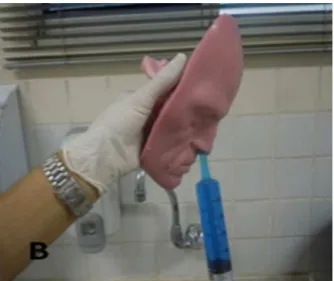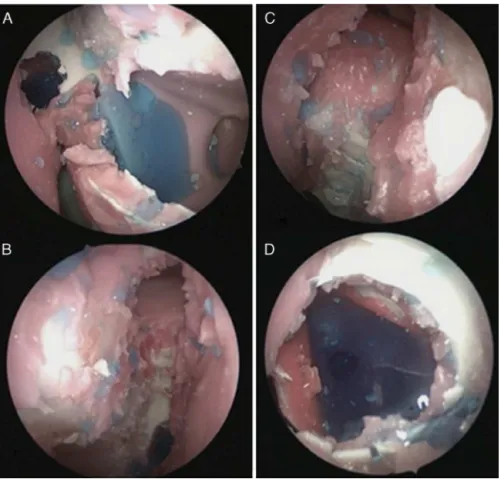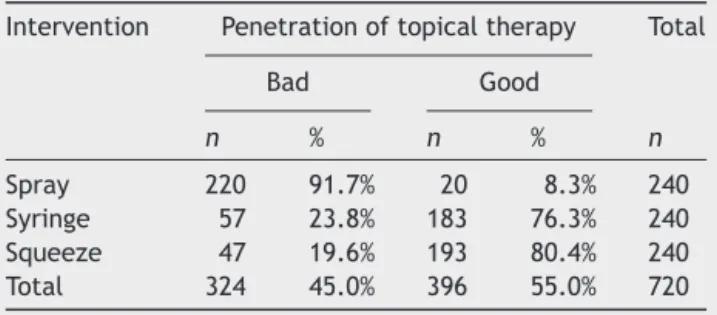www.bjorl.org
Brazilian
Journal
of
OTORHINOLARYNGOLOGY
ORIGINAL
ARTICLE
Efficacy
of
syringe-irrigation
topical
therapy
and
the
influence
of
the
middle
turbinate
in
sinus
penetration
of
solutions
夽
Guilherme
Henrique
Wawginiak
a,
Leonardo
Balsalobre
a,b,
Eduardo
Macoto
Kosugi
b,∗,
João
Paulo
Mangussi-Gomes
a,b,
Raul
Ernesto
Samaniego
a,
Aldo
Cassol
Stamm
aaComplexoHospitalarEdmundoVasconcelos,CentrodeOtorrinolaringologiaeFonoaudiologia,SãoPaulo,SP,Brazil
bUniversidadeFederaldeSãoPaulo,EscolaPaulistadeMedicina,DepartamentodeOtorrinolaringologiaeCirurgiadeCabec¸ae
Pescoc¸o,SãoPaulo,SP,Brazil
Received15January2016;accepted28June2016 Availableonline31July2016
KEYWORDS
Sinusitis/therapy; Therapeutic irrigation; Video-assisted surgery; Naturalorifice endoscopicsurgery
Abstract
Introduction:Topicaltherapiesarethebestpostoperativetreatmentoptionforchronic rhinos-inusitis,especiallythosewithhighvolumeandpressure,suchasthesqueezebottles.However, theyarenotanavailableoptioninBrazil,whereirrigationsyringesareused.
Objective:Toinvestigatetheefficacyoftopicalsinonasaltherapywithsyringeandtheinfluence ofthemiddleturbinateonthisprocess
Methods:Interventionstudyintrainingmodels(S.I.M.O.N.T.).Afterstandarddissection,three interventionswereperformed(NasalSpray4puffs,60-mLsyringeand240-mLSqueezeBottle) withnormalandSuturedMiddleTurbinate.Imagesofeachsinuswerecapturedafterthe inter-ventions,totalizing144images.Theimageswereclassifiedby10evaluatorsaccordingtothe amountofresidualvolumefromzeroto3,withzeroand1beingconsideredpoorpenetration and2and3,goodpenetration.The1440evaluationswereusedinthisstudy.
Results:Consideringallmiddleturbinatesituations,theamountofgoodpenetrationswere8.1% forSpray;68.3%forSyringe,and78.3%forSqueeze(p<0.0001).Consideringalltypesof inter-ventions,theNormalMiddleTurbinategrouphad48.2%ofgoodpenetrationsandtheSutured MiddleTurbinate,55%(p=0.01).ConsideringonlytheSuturedMiddleTurbinates,therewasno differencebetweentheinterventionswithSyringeandSqueeze(76.3%vs.80.4%;p=0.27).
夽 Please cite this article as: Wawginiak GH, Balsalobre L, Kosugi EM, Mangussi-Gomes JP, Samaniego RE, Stamm AC. Efficacy of syringe-irrigationtopical therapyand theinfluenceofthemiddleturbinateinsinuspenetration ofsolutions.Braz JOtorhinolaryngol. 2017;83:546---51.
∗Correspondingauthor.
E-mail:edumacoto@uol.com.br(E.M.Kosugi).
PeerReviewundertheresponsibilityofAssociac¸ãoBrasileiradeOtorrinolaringologiaeCirurgiaCérvico-Facial.
http://dx.doi.org/10.1016/j.bjorl.2016.06.013
1808-8694/©2017Associac¸˜aoBrasileiradeOtorrinolaringologiaeCirurgiaC´ervico-Facial.PublishedbyElsevierEditoraLtda.Thisisanopen
Conclusion: Topicaltherapyofirrigationwitha60-mLsyringewasmore effectivethanthat withnasalspray.Thestatusofthemiddleturbinateprovedtobefundamentalandinfluenced topicaltherapy.Irrigationwithsyringewasaseffectiveasthesqueezebottlewhenthemiddle turbinatewassuturedtothenasalseptum.
© 2017 Associac¸˜ao Brasileira de Otorrinolaringologia e Cirurgia C´ervico-Facial. Published by Elsevier Editora Ltda. This is an open access article under the CC BY license (http:// creativecommons.org/licenses/by/4.0/).
PALAVRAS-CHAVE
Sinusite/terapia; Irrigac¸ãoterapêutica; Cirurgia
vídeoassistida; Cirurgiaendoscópica pororifícionatural
Eficáciadaterapiatópicadeirrigac¸ãocomseringaeainfluênciadaconchamédiana penetrac¸ãosinusaldesoluc¸ões
Resumo
Introduc¸ão: Terapiastópicassãoamelhoropc¸ãodetratamentopós-operatóriodarinossinusite crônica,principalmentecomaltovolumeepressão,comoossqueezebottles.Porém,nãosão opc¸ões disponíveisnarealidadebrasileira,ondefrequentementesãousadosseringaspara a irrigac¸ão.
Objetivo: Averiguar aeficácia daterapia tópicanasossinusal comseringae ainfluência da conchamédianesteprocesso.
Método: Estudo de intervenc¸ão em modelos de treinamento (S.I.M.O.N.T.). Apósdissecc¸ão padronizada,trêsintervenc¸õesforamrealizadas(spraynasal4puffs,seringade60mLesqueeze bottlede240mL)comaconchamédianormalesuturada.Foramcapturadasimagensdecada seioapósasintervenc¸ões,totalizando144imagens.Asimagensforamclassificadaspor10 avali-adoresdeacordocomaquantidadedevolumeresidualdezeroa3,sendozeroe1considerados penetrac¸ãoruime2e3,penetrac¸ãoboa.As1.440avaliac¸õesforamutilizadasnesteestudo.
Resultados: Considerandotodasassituac¸õesdeconchamédia,aquantidadedepenetrac¸ões boasforam8,1%paraspray;68,3%paraseringae78,3%parasqueeze(p<0,0001).Considerando todosostiposdeintervenc¸ão,aconchamédianormalobteve48,2%depenetrac¸õesboasea conchamédiasuturada,55%(p=0,01).Considerandoapenasconchamédiasuturada,nãohouve diferenc¸aentreasintervenc¸õesseringaesqueeze(76,3%vs.80,4%;p=0,27).
Conclusão:Aterapiatópicadeirrigac¸ãocomseringade60mLfoimaiseficazquecomspray nasal. Ostatus daconcha médiamostrou-se fundamentale influencioua terapiatópica. A irrigac¸ãocomseringafoitãoeficazquantoàcomsqueezebottlequandoaconchamédiafoi suturadaaoseptonasal.
© 2017 Associac¸˜ao Brasileira de Otorrinolaringologia e Cirurgia C´ervico-Facial. Publicado por Elsevier Editora Ltda. Este ´e um artigo Open Access sob uma licenc¸a CC BY (http:// creativecommons.org/licenses/by/4.0/).
Introduction
ChronicRhinosinusitis(CRS)isdefinedasachronic inflam-matoryprocessofthenasalmucosaandparanasalsinuses, lasting more than 12 weeks without complete resolution of symptoms.1,2 This chronic inflammation of the mucosa
canbecausedbyseveraldistinctpathophysiological mecha-nisms,makingthetermCSRan‘‘umbrella’’termthathouses severaldifferentdiseasespresentingwithnasalobstruction, rhinorrhea,olfactorychangesand/orfacialpain.3
Nasal irrigation,despite thegrowing interest inrecent years4,5isaveryoldtreatmentthathasbeenpracticedfor
centuries in India during the practice of yoga, and since the19thcenturyinWesternmedicine.6Historically, ithas
employedseveral solutions, such assodium chloride, and differentinstruments,suchassyringesandbottlesfornasal washings.7Althoughmostoftheseagentsarenotcurrently
used, the practiceof nasal irrigationwith saline solution persisted, and has gained popularitythroughout the 20th
century. It is now considered effective in the control of sinonasaldiseaseandisacornerstoneinthepostoperative care.8
Severalnasalirrigationtechniquesanddeviceshavebeen developed over the years, with variations in the applied solutionpressure andvolume.Low-volume devicesutilize around 100L in sprays up to a few milliliters for
drop-pers, atomizers and nebulizers. The high-volume systems deliverfrom50mL to240mLthroughsqueezebottlesand netipots.FollowingEndoscopicSinonasalSurgery(ESS),the high-volumeirrigationsystemsprovidegooddistributionof thesolutioninthenasalcavityandcribiformplate,and par-ticularlyhavebetterpenetrationintothesinus.Thegreater thevolumeofirrigation,thegreaterthedistributiontothe sinuscavities.9---11
Therefore,ESSprimaryroleinCSRisnowtopreparethe paranasalsinusestoreceivetopicalmedications,especially in the form of irrigation.12 Technical factors may impair
espe-Figure1 Modelafterstandarddissection.(A)Middle turbinatekeptwith notreatmentafterdissection.(B)Middle turbinate suturedtotheseptumafterdissection.
cially between the Middle Turbinate (MT) and the lateral nasalwall.13 Frequently themiddleturbinate is mobilized
and,notinfrequentlybecomesinstableduringsurgery, lead-ingtoitslateralizationand/oradherence.13---15
ThecontroversybetweenpreservingorremovingtheMT is as old as the history of ESS. Those who condemn MT resectionspeakofthechangeofnasalfunction,theriskof frontalCRS,thelossof animportantanatomicallandmark for revision surgeries, the risk of anosmia, or the exces-sive formation of scar tissue. Those who favor partial or totalresection of MT believe in thebenefits in enhanced postoperative care, reduction of synechiae, and greater accessibilitytothesinuses.16---18 An intermediateapproach
tothesetwoviewsincludetheuseofspacerdevicesinthe middle meatusand suturing the middle turbinates tothe nasalseptum.14,15
In Brazil, there are no marketed devices that provide highsolutionvolumeswithpressure,sothelocalrealityis theuseofsyringesfortheadministrationofcorticosteroids solutions.19However,thereisnoevidencethatthistypeof
applicationissimilartotechniquesalreadydescribed,nor isthereevidenceoftheinfluenceof themiddleturbinate inthistopicaltherapymodality.Therefore,theaimofthis study was to examine the efficacy of topical nasosinusal therapywithasyringe,andtheinfluenceofthemiddlenasal conchainthisprocess.
Methods
Thisisaninterventionstudyinamodelofsinonasal dissec-tion,wherethreedifferentinterventionsoftopicaltherapy weretestedintwospecificgroupsofpositionofthemiddle turbinate.
We usedthreeunitsof the sinusmodel otorhino-neuro training of endoscopic surgery (SIMONT) produced by Pro Delphos®(Recife,Brazil),inwhichthesameotolaryngologist
surgeon(LLBF)conducted standardized surgicaldissection (fronto-spheno-maxillo-ethmoidectomy)inbothnasal cavi-ties,totalingsixnasalcavitiesdissected.Allthreemodels have received, in addition to standard surgical dissec-tion,two sequential treatments of the middle turbinate, correspondingtothedivisionintotwogroups:first,the mid-dleturbinatewaskeptinitsusualpositionafterdissection
andmatchedtheNormalMiddleTurbinategroup(Fig.1A). Secondly,themiddleturbinatesweresuturedtogetherwith asinglestitchofNylon3---0suturetransfixingthenasal sep-tum(Fig.1B), withthe groupbeingcalledSuturedMiddle Turbinategroup.
In each model, three interventions of topical therapy wereperformed.Thelavagesolutionwaspreparedby dilut-ing10dropsof bluefooddye in500mLof water.Asingle investigatorperformed allinterventionsoftopicaltherapy withthe S.I.M.O.N.T.model in orthostatic position, simu-lating anterior flexion of the neck of about 30◦ (Fig. 2).
Thefirstinterventionconsistedoffouratomizationsofnasal sprayineachnostril,whichcorrespondedto0.2mLof solu-tion per nostril, and it was called Spray intervention. In thesecondintervention,a60-mLsyringewithcathetertip (Injex,Ourinhos,SP,Brazil)wasused,withallthisvolume injectedintoasingleapplicationunderpressureineach nos-tril, andthisinterventionwascalled Syringeintervention. Andthelastinterventionwasperformedwitha240-mL bot-tle(squeezebottle)forhigh-volume,high-pressuretopical therapy(SinusRinse,NeilMedPharmaceuticals,Inc.,Santa
Figure3 Examplesofhighamountoffluidinthesinuses.(A)Leftmaxillarysinus;(B)rightEthmoidsinus;(C)rightfrontalsinus; (D)leftsphenoidalsinus.
Rosa,California,EUA),withhalfofthisvolumeinjectedinto asingleapplicationunderpressureineachnostril,andwas calledSqueezeintervention.
Aftereachintervention,a30◦rigidendoscopeconnected
toarecordingsystem witha cameraandlight sourcewas introducedin thenasalfossae, withendoscopicimagesof themaxillary,ethmoid,frontalandsphenoidsinusesbeing captured, always taking care not to allow the identifica-tionof thetreatment performed in the middleturbinate. Afterregistration,themodelwaswashedwithrunningwater andsuctioned toensure the removalof allthe dye used. Therefore,initially,threeinterventionswereperformedin threemodelswithNormalMiddleTurbinate;thenthemiddle turbinatesofthethreemodelsweresutured,andthethree interventionsinthethreemodelswereperformedagain.
Animageofeachsinuswascapturedforeach interven-tion in each MT group, totaling 144 images (1 image×3 interventions×2 MT groups×4 sinuses×6 sides), which were placed in a PowerPoint presentation and numbered 1through144, withnoindication ofthe middleturbinate grouportopicaltherapyinterventionperformed.
The imageswereclassified accordingtothe amountof residualvolumeinasemi-quantitativescale.Thescoresthat couldbeattributed toeach sinus were:0 (nofluidin the cavity),1(lowamount offluidinthecavity),2(moderate amountoffluidinthecavity)and3(largeamount offluid inthecavity).Allimageswereanalyzedbytenevaluators, whoweretrainedotolaryngologists,whowerenotinvolved intopicaltherapies or imagescanning,totaling 1440
ana-lyzes.Tostandardizetheassessment,theauthorspreviously showedexamplestotheevaluatorsofwhattheyconsidered alarge amountoffluidineachofthesinuses (Fig.3A---D). Thescores0and1havebeenconsideredPoorPenetrationto thesinuses,whilethescores2and3wereconsideredGood Penetration.
The statisticalanalysisconsisted ofthe chi-squaretest (or Fisher’s exact when necessary), considering categor-ical variables (Bad or Good Penetration) in the groups studied (Spray vs. Syringe vs. Squeeze, or Normal Mid-dleTurbinatevs.SuturedMiddleTurbinate).Inter-observer concordanceanalysiswasassessedusingthekappatest.For allstatisticaltestspvalueslowerthan5%wereconsidered significant.
Results
Inter-observer agreement was considered large (Kappa= 0.628,p<0.001;0.604---0.653).
The threeinterventions showed to be different as for sinus penetration (p<0.0001). Syringe intervention was moreeffectivethantheSprayone(68%ofgoodreviewsfor thesinuspenetrationvs.8%),butpoorerthantheSqueeze intervention(68%vs.78%),asshowninTable1.
Table 1 Penetration of topical therapy in each intervention.
Intervention Penetrationoftopicaltherapy Total
Bad Good
n % n % n
Spray 441 91.9% 39 8.1% 480 Syringe 152 31.7% 328 68.3% 480 Squeeze 104 21.7% 376 78.3% 480 Total 697 48.4% 743 51.6% 1440
n,number;%,percentage. Chi-squaretest:p<0.0001.
Table2 Penetration oftopicaltherapy accordingtothe middleturbinate.
Middleturbinate Penetrationoftopicaltherapy Total
Bad Good
n % n % n
Normal 373 51.8% 347 48.2% 720 Sutured 324 45.0% 396 55.0% 720 Total 697 48.4% 743 51.6% 1440
n,number;%,percentage. Chi-squaretest:p=0.01.
middleturbinatewasinnormalpositioninthepostoperative period,asshowninTable2.
Consideringthepenetrationoftopicaltherapies accord-ing to the status of the middle turbinate, it was noted thatin the Normal MiddleTurbinate case, the initial pat-tern of penetration, Squeeze>Syringe>Spray, was kept (Table3).However,whenconsideringonlytheSutured Mid-dleTurbinate case, theSyringe interventionproved tobe similartotheSqueeze(76%vs.80%,p=0.27)(Table4).
Discussion
The present study demonstrated that topical treatment with 60-mL syringe was more effective than nasal spray regardless of the middle turbinate situation, and was as
Table3 PenetrationoftopicaltherapywithNormalMiddle Turbinate.
Intervention Penetrationoftopicaltherapy Total
Bad Bad
n % n % n
Spray 221 92.1% 19 7.9% 240 Syringe 95 39.6% 145 60.4% 240 Squeeze 57 23.8% 183 76.3% 240 Total 373 51.8% 347 48.2% 720
n,number;%,percentage.
Chi-squareTest:Sprayvs.Syringevs.Squeezep<0.0001;Spray
vs.Syringep<0.0001;Sprayvs.Squeezep<0.0001;Syringevs. Squeezep<0.0001.
Table4 PenetrationoftopicaltherapywithSuturedMiddle Turbinate.
Intervention Penetrationoftopicaltherapy Total
Bad Good
n % n % n
Spray 220 91.7% 20 8.3% 240 Syringe 57 23.8% 183 76.3% 240 Squeeze 47 19.6% 193 80.4% 240 Total 324 45.0% 396 55.0% 720
n,number;%,percentage.
Chi-squaretest:Sprayvs.Syringevs.Squeezep<0.0001;Spray
vs.Syringep<0.0001;Sprayvs.Squeezep<0.0001;Syringevs. Squeezep=0.27.
effectiveasthesqueezebottleinterventionwhen adminis-teredfollowingmiddleturbinatesuturing.FortheBrazilian reality,thisstudyprovedtobeessential,sincethereareno squeezebottlescommerciallyavailableinthismarket,and thetopicalirrigationtherapiesareroutinelyperformedwith syringes. The only Brazilian study published to date with irrigation of corticosteroids wasadministered with 20-mL syringes,showingthatthisisactuallythenationalreality.19
Therearenotmanytopicaltherapystudiesofirrigation withsyringes. Snidvongs etal.20 compared sinus
penetra-tionaftertopicaltherapywith50-mLsyringes(using40mL of solution) and nasal spray (10mL). However,unlike the presentstudythatevaluatedthesinuspenetrationpost-ESS, thestudy bySnidvongs etal.evaluatedpatients withCRS withnoprevioussurgery,provingthatthesinuspenetration innon-operatedsinusesisnegligible,regardlessofthe tech-niqueused.Evenso,thevolumeretainedinthenasalcavity wassignificantlyhigherwiththe50-mLsyringe.20
Abadie et al.10 performed a study on cadavers, all
after ESS, which compared various irrigation techniques, dividedintohigh-volumeirrigations,andsprays,where bet-ter results of sinus penetration results with high-volume irrigationwasobserved,similarlytothisstudy.Ofthe sev-eralhigh-volumeirrigationtechniques, thesqueezebottle interventionwasmoreeffective,withthismodelbeingused inourstudy.Theconfirmationofthisstudythattopical ther-apywithasyringeismoreeffectivethanthesprayisenough tojustifyitsroutineuseinournationalreality incasesof failureofthespray.19Moreover,thefindingthatthesyringe
is almost asefficacious asthesqueezebottle(considered to be the best technique of topicaltherapy in the study by Abadie et al.10) when the middle turbinate is sutured
is essentialtoconfirm thatthe useof thesyringemaybe regarded asthebest therapeuticoption for patientswith CRSpostoperativelyinourreality.
In addition, it is important to emphasize the role of surgeryinthetopicalnasaltherapy.Harveyetal.21
which there is the need for physical irrigation access to thesinuses.Therefore,themiddleturbinate,withits cen-tral position in the nasal cavity, could play a role in the efficacy of topicaltherapy. This study confirmed that the position of the middle turbinate can influence sinus pen-etration, with the transeptal suture of middle turbinates facilitatingsinuspenetrationoftopicaltherapiesingeneral, andalsoequalingtheefficiencyof60-mLsyringetothatof thesqueezebottle.Therefore,it isnecessarytotreat the middleturbinateinordertoimprovetheefficacyoftopical therapyofirrigationwithasyringe.
Conclusion
In models of surgical nasal dissection, topical therapy of irrigationwitha60-mLsyringewasmoreeffectivethanthat withnasalspray.Thestatusofthemiddleturbinateproved tobefundamentalandinfluencedtopicaltherapy.Irrigation withasyringewasaseffectiveasthatwithasqueezebottle whenthemiddleturbinatewassuturedtothenasalseptum.
Conflicts
of
interest
Theauthorsdeclarenoconflictsofinterest.
References
1.Anselmo-LimaWT,SakanoE,TamashiroE,NunesAA,Fernandes AM,PereiraEA,etal.Rhinosinusitis:evidenceandexperience: October18and19,2013---SãoPaulo.BrazJOtorhinolaryngol. 2015;81:S1---49.
2.FokkensWJ,LundVJ,MullolJ,BachertC,AlobidI,BaroodyF, etal.EuropeanpositionpaperonRhinosinusitisandNasalPolyps 2012.RhinolSuppl.2012;50:1---298.
3.TimperleyD,SchlosserRJ,HarveyRJ.Chronicrhinosinusitis:an educationandtreatmentmodel.OtolaryngolHeadNeckSurg. 2010;143:S3---8.
4.Snidvongs K, Kalish L, Sacks R, Craig JC, Harvey RJ. Topi-calsteroidforchronicrhinosinusitiswithoutpolyps.Cochrane DatabaseSystRev.2011;8:CD009274.
5.KalishL,SnidvongsK,SivasubramariamR,CopeD,HarveyRJ. Topicalsteroidsfornasalpolyps.CochraneDatabaseSystRev. 2012;12:CD006549.
6.BurnsJ.Nasallavage.JOtolaryngol.1992;21:83.
7.WingraveW.Aclinicallectureonthenatureofdischargesand douches.Lancet.1902;159:1373---5.
8.HarveyR, HannanSA,Badia L, ScaddingG. Nasalsaline irri-gations for thesymptomsof chronicrhinosinusitis. Cochrane DatabaseSystRev.2007;3:CD006394.
9.WormaldP-J,Cain T,Oates L,HawkeL,WongI.A compara-tivestudyofthreemethodsofnasalirrigation.Laryngoscope. 2004;114:2224---7.
10.AbadieWM,McMainsKC,WeitzelEK.Irrigationpenetrationof nasaldeliverysystems:acadaverstudy.IntForumAllergy Rhi-nol.2011;1:46---9.
11.HarveyRJ,SchlosserRJ.Localdrugdelivery.OtolaryngolClin NorthAm.2009;42:829---45,ix.
12.Harvey RJ, Goddard JC, Wise SK, Schlosser RJ. Effects of endoscopicsinussurgeryanddeliverydeviceoncadaversinus irrigation.OtolaryngolHeadNeckSurg.2008;139:137---42.
13.Friedman M, Landsberg R, Tanyeri H. Middle turbinate medialization and preservation in endoscopic sinus surgery. OtolaryngolHeadNeckSurg.2000;123:76---80.
14.BhallaRK, KaushikV,deCarpentier J.Conchopexysutureto preventmiddleturbinatelateralisationandseptalhaematoma afterendoscopicsinussurgery.Rhinology.2005;43:143---5.
15.Yanagisawa E, Joe JK. The use of spacers to prevent post-operative middle meatal adhesions. Ear Nose Throat J. 1999;78:530---2.
16.SolerZM,HwangPH,MaceJ,SmithTL.Outcomesaftermiddle turbinateresection:revisitinga controversialtopic. Laryngo-scope.2010;120:832---7.
17.Shih C,ChinG, RiceDH.Middleturbinate resection:impact onoutcomes inendoscopicsinus surgery.Ear NoseThroatJ. 2003;82:796---7.
18.Biedlingmaier JF. Endoscopic sinus surgery with middle turbinateresection:resultsandcomplications.EarNoseThroat J.1993;72:351---5.
19.Kosugi EM, Moussalem GF, Simões JC, de Souza RP, Chen VG, Saraceni-NetoP,et al.Topicaltherapywithhigh-volume budesonidenasalirrigationsindifficult-to-treatchronic rhinos-inusitis.BrazJOtorhinolaryngol.2016;82:191---7.
20.SnidvongsK,ChaowanapanjaP,AeumjaturapatS,ChusakulS, PraweswararatP.Doesnasalirrigationenterparanasalsinuses inchronicrhinosinusitis.AmJRhinol.2008;22:483---6.
21.HarveyRJ,DebnathN,SrubiskiA,BleierB,SchlosserRJ.Fluid residuals and drug exposure in nasal irrigation. Otolaryngol HeadNeckSurg.2009;141:757---61.


